Network Slicing Market Size
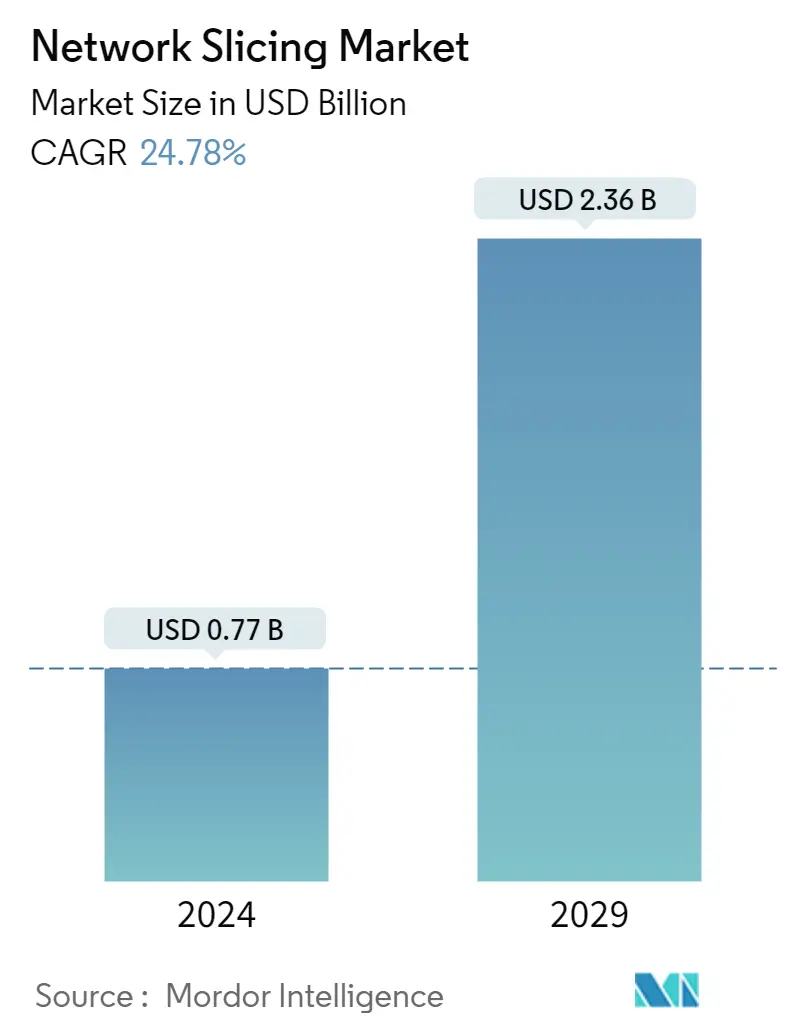
| Study Period | 2019 - 2029 |
| Market Size (2024) | USD 0.77 Billion |
| Market Size (2029) | USD 2.36 Billion |
| CAGR (2024 - 2029) | 24.78 % |
| Fastest Growing Market | Asia Pacific |
| Largest Market | North America |
Major Players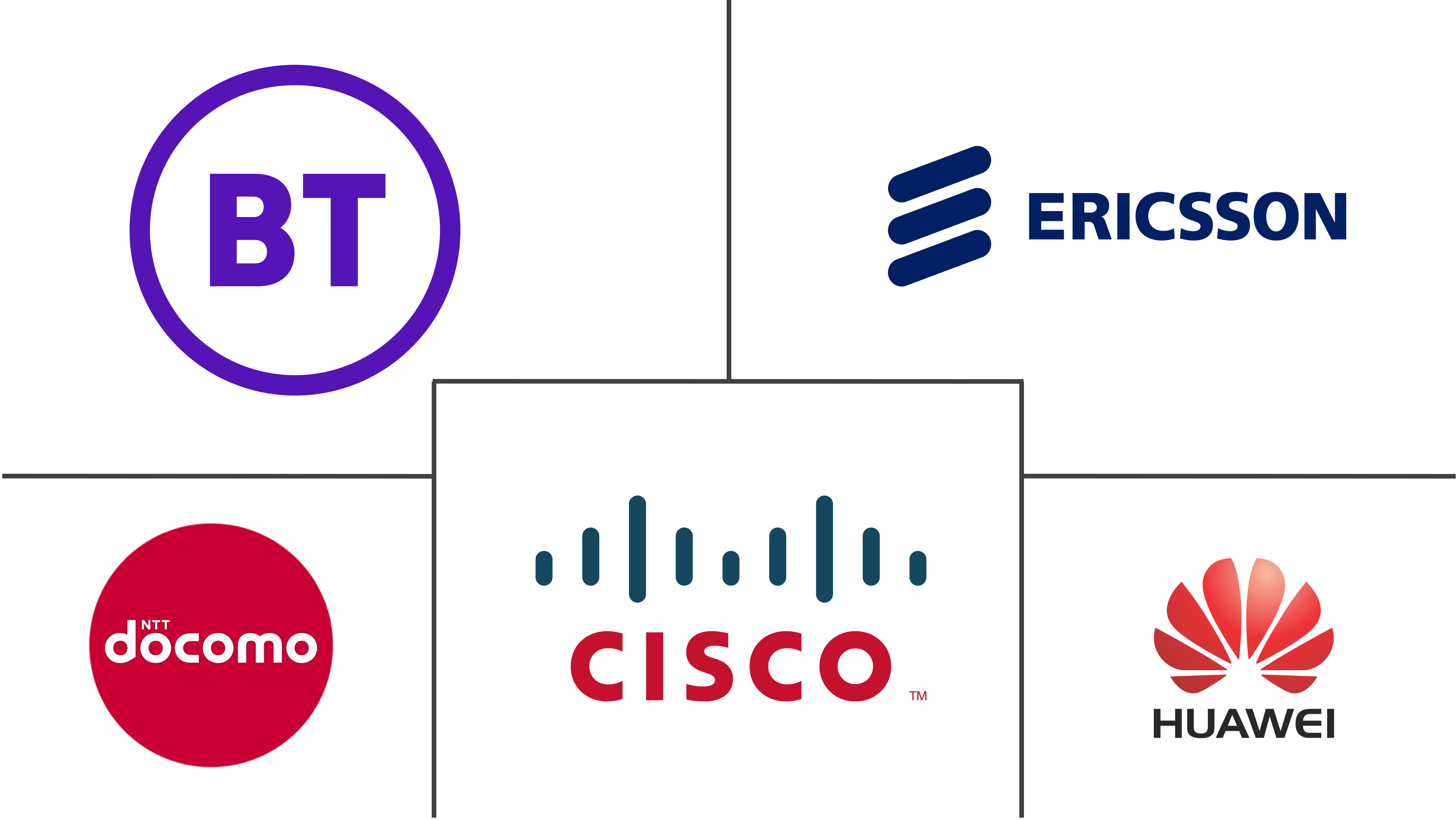
*Disclaimer: Major Players sorted in no particular order |
Network Slicing Market Analysis
The Network Slicing Market size is estimated at USD 0.77 billion in 2024, and is expected to reach USD 2.36 billion by 2029, growing at a CAGR of 24.78% during the forecast period (2024-2029).
According to GSMA, network slicing, in combination with other enablers and capabilities, will aid operators in addressing a revenue opportunity worth USD 300 billion by 2025.
- 5G networks, in combination with network slicing, allow business customers to enjoy connectivity and data processing that are tailored to the specific business requirements and adhere to a Service Level Agreement (SLA) as agreed with the mobile operator. Customizable network capabilities include data speed, latency, quality, security, and services. Thus as the demand for high-speed network coverage is progressing, it will open new avenues for the market.
- However, 5G is struggling to keep pace in emerging economies due to low bandwidth and a lack of infrastructure. For instance, India's smart city initiative launched two years ago has struggled to make significant progress. Beyond the numerous local regulatory and structural challenges, there needs to be more spectrum or even the right spectrum bands available for the smart city vision to be realized.
- Various industries are being transformed by the widespread use of IoT and ongoing improvements in Machine-to-Machine (M2M) communication networks, which are connecting all different kinds of equipment, systems, and services. One of the many use cases that network slicing-enabled 5G will allow is the Internet of Things, which would provide communication between a significant number of sensors and linked devices. High-power, low-latency applications (such as mobile video surveillance) and low-power, low-latency, long-range IoT applications are two categories of IoT application requirements (smart cities and smart factories). To meet these needs for growing IoT applications, which are characterized as huge machine-type communication and mission-critical applications, the evolution of 5G Technology is anticipated to pick up speed.
- However, Network slicing security, which may cause significant losses for enterprises and service providers, is a major worry for CIOs. SDN, NFV, and cloud-native architecture have all been used to construct the new network infrastructure. Network functions are spread across local, regional, and central data centers and are decoupled from supporting infrastructure. The vast majority of network services in a 5G network based on the cloud are implemented through public and private cloud infrastructure.
- With the aid of expanding mobile networking and remote access services in a number of industries, including retail, telecom, IT, and healthcare, the pandemic has considerably driven demand for broadband services. Additionally, as businesses all around the world have begun to reopen, communications service providers are refocusing on 5G rollouts and stepping up their network-slicing efforts. Additionally, COVID-19 has increased interest in 5G use cases, including robotics, telemedicine, remote education, and remote offices, all contributing to the network-slicing market.
Network Slicing Market Trends
This section covers the major market trends shaping the Network Slicing Market according to our research experts:
Healthcare Sector to Dominate the Market
- Millions of medical devices, from at-home clinical diagnostic equipment to hospital-based multimillion-dollar imaging systems, increasingly demand connectivity as a key value-added feature. Ericsson estimates a USD 76 billion revenue opportunity in 2026 for operators addressing healthcare transformation with 5G.
- It will enable many new approaches in the healthcare sector in terms of imaging, diagnosis, and data analytics. For instance, hospitals could arrange remote robotic surgeries, as if the surgeon is right next to the patient, using virtual reality via a customized 5G network slice.
- Also, it can be used in medical data management by maintaining electronic health records or introducing ambulance drones. Medical device makers can utilize 5G to monitor their products' functionality in real-time, providing proactive and predictive maintenance assistance and preventing negative outcomes brought on by faulty equipment. Certain crucial applications in healthcare demand extremely low latency and highly stable bandwidth.
- European Telecommunications Network Operator's Association forecasts that the number of IoT connections in healthcare will reach 10.34 billion by 2025. This is made feasible by the Internet of Medical Things (IoMT), a network of interconnected medical equipment, software programs, and health systems that use edge computing and 5G wireless technology to process data close to the source.
- According to an ETNO-European Telecommunications Network Operators' Association survey, the number of IoT healthcare active connections was expected to increase through the years. It was at 0.87 million connections in 2016 and is expected to reach 10.34 million by 2025.
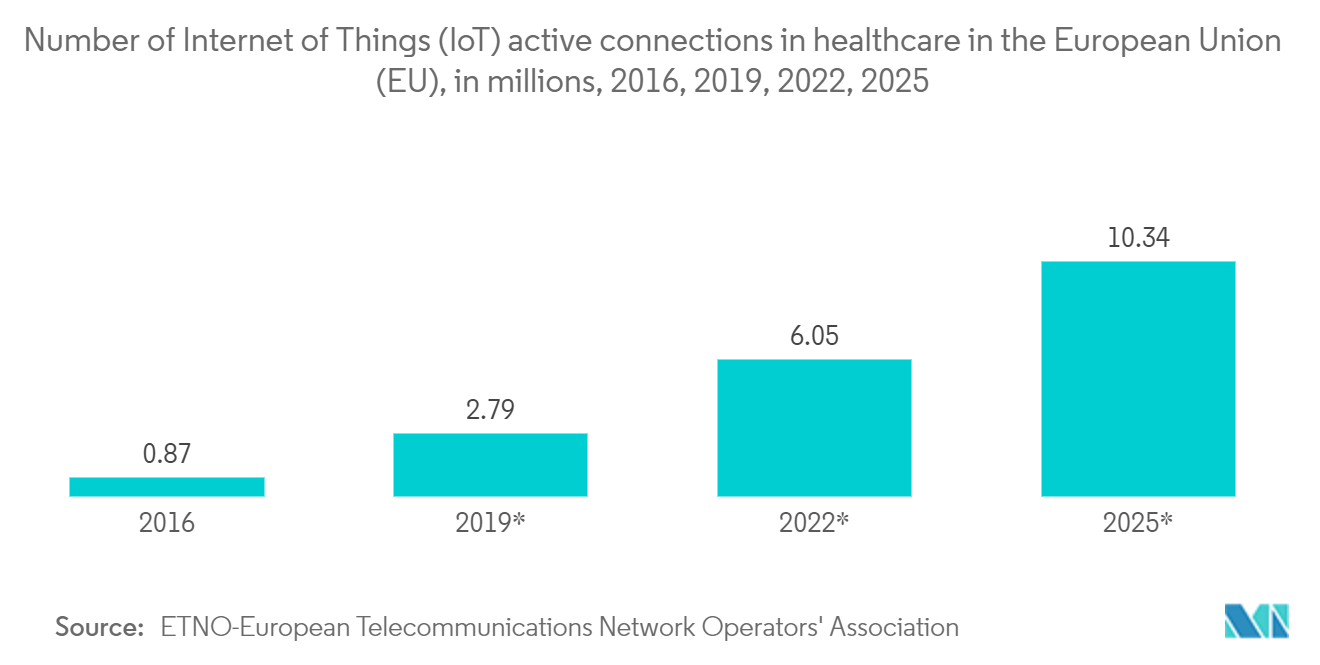
Asia-Pacific to Witness the Highest Growth
- Several developing economies in APAC, including China, India, and Japan, are anticipated to have rapid expansion in the network-slicing industry. These nations have consistently encouraged and supported the advancement of industry and technology. They also have a sophisticated technological infrastructure that is encouraging the adoption of network-slicing solutions in various business sectors. The increased use of cloud-based solutions, cutting-edge technologies like the IoT, big data analytics, and mobility are what is driving the network industry in APAC. One of the largest markets for connected devices is in APAC.
- APAC is expected to grow at the fastest rate owing to the development of network infrastructure and 5G being the biggest telecom trend. According to GSMA, the Asia Pacific area mobile operators plan to spend USD 227 billion between 2022 and 2025 on 5G deployments. That is a significant sum of money and will have a significant effect. In addition to enabling innovative new consumer services, these new networks are assisting in the transformation of business and manufacturing as well as promoting economic growth.
- Connectivity will be essential to rebuilding Asia-economies Pacific and making them more resilient to future shocks as the region attempts to recover from the pandemic. In order to fully realize the potential of a post-pandemic digital economy, 5G networks, cloud services, edge computing, artificial intelligence (AI), big data, and the Internet of Things will all be crucial.
- 5G's network slicing capabilities will allow telcos to offer critical service providers their own private 5G networks for secure and real-time connectivity to the cloud, helping to meet their ever-evolving infrastructure needs and improve operational efficiency.
- It is expected to increase and will profit from the addition of 5G network slicing to the current technology stack, i.e., together with private networks, Multi-access Edge Computing (MEC), etc. As 5G enters the mass-market phase, the monetization potential for mobile operators is beginning to take shape along with more adaptable and real-time Operations Support System and Business Support System (OSS/BSS) capabilities.
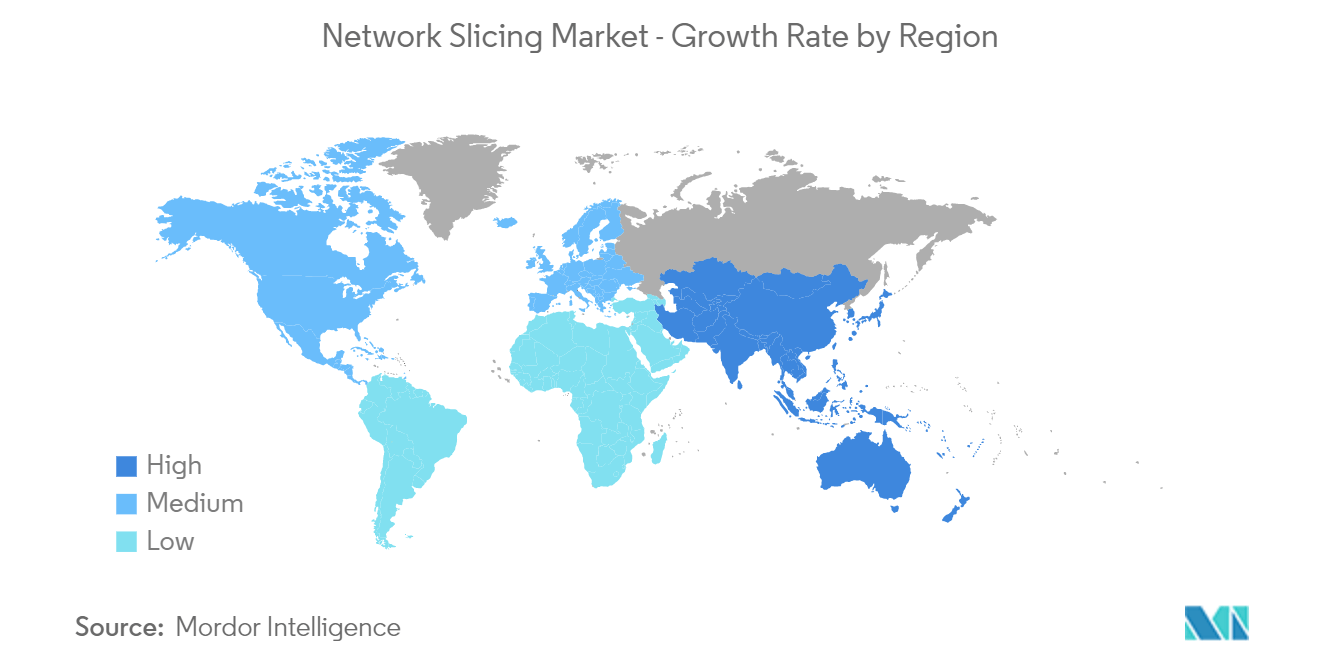
Network Slicing Industry Overview
The Network Slicing Market is fragmented, with players collaborating to provide the required availability, a specified latency, data rate, and security. Network slice management solutions can also help carriers implement network slice lifecycle management in the preparation of 5G. Some major players are Ericsson Inc., Huawei Technologies Co. Ltd, Cisco Systems Inc., and BT Group PLC.
- November 2022 - To include security, SD-WAN, and zero trust into a wireless WAN architecture, Cradlepoint unveiled a new "network slicing-ready" 5G-optimized SD-WAN as part of the company's NetCloud Exchange solution it unveiled earlier this year. Organizations can now construct "many modem WAN interfaces aligned to slice instances defined by 5G standalone (SA) networks" using NetCloud Exchange.
Network Slicing Market Leaders
-
Ericsson Inc.
-
Huawei Technologies Co. Ltd
-
Cisco Systems Inc.
-
BT Group PLC
-
NTT DOCOMO Inc.
*Disclaimer: Major Players sorted in no particular order
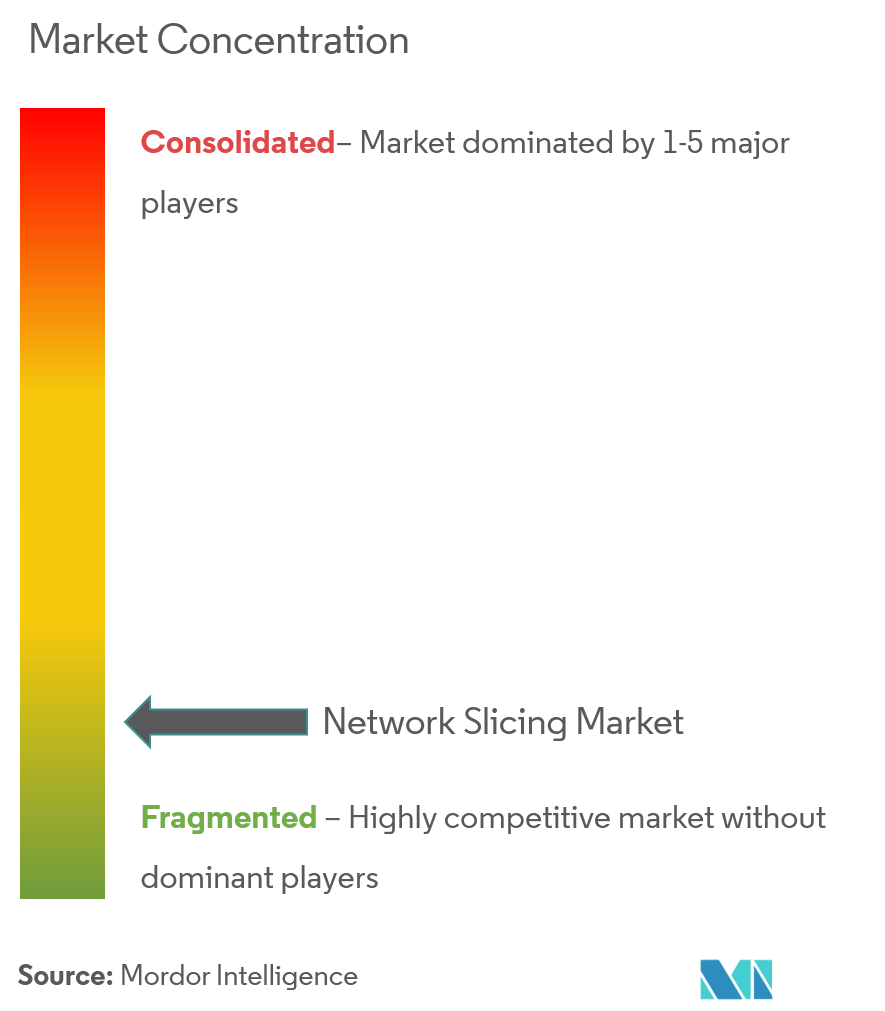
Network Slicing Market News
- July 2022 - Laboratory effort to orchestrate an end-to-end automated network slicing concept in a 5G standalone (SA) environment, including lifecycle support and radio resource portioning, was led by Spain's Telefónica, Ericsson, and Google. According to a laboratory test, a network slice could be onboarded from the core to the radio access network (RAN) in less than 35 minutes. These included what they referred to as "complicated service configurations," which necessitated complete automation to manage the network slice's provisioning and service assurance.
- February 2022 - A ground-breaking proof of concept for global 5G end-to-end network slicing was unveiled by Deutsche Telekom and Ericsson in order to enable consistent worldwide connection for latency-sensitive enterprise applications with guaranteed Quality of Service. This worldwide 5G slicing trial comprises SD-WAN, end-to-end service orchestration, and managed connectivity for latency-critical applications in many nations in a very flexible and consistent manner, which is a first for the industry. This strategy will be beneficial for multinational corporations that operate latency-sensitive applications across numerous foreign subsidiaries.
Network Slicing Market Report - Table of Contents
1. INTRODUCTION
- 1.1 Study Deliverables
- 1.2 Study Assumptions
- 1.3 Scope of the Study
2. RESEARCH METHODOLOGY
3. EXECUTIVE SUMMARY
4. MARKET DYNAMICS
- 4.1 Market Overview
- 4.2 Introduction to Market Drivers and Restraints
-
4.3 Market Drivers
- 4.3.1 Increasing Demand For High-speed And Large Network Coverage is Major Driving Force
-
4.4 Market Restraints
- 4.4.1 Low 5G Penetration in Emerging Economies is Challenging the Market Growth
-
4.5 Industry Attractiveness - Porter's Five Force Analysis
- 4.5.1 Threat of New Entrants
- 4.5.2 Bargaining Power of Buyers/Consumers
- 4.5.3 Bargaining Power of Suppliers
- 4.5.4 Threat of Substitute Products
- 4.5.5 Intensity of Competitive Rivalry
5. MARKET SEGMENTATION
-
5.1 By Application
- 5.1.1 Real-Time Surveillance
- 5.1.2 Network Function Virtualization
-
5.2 By Service
- 5.2.1 Professional
- 5.2.2 Managed
-
5.3 By End-user Industry
- 5.3.1 Healthcare
- 5.3.2 Automotive
- 5.3.3 Power & Energy
- 5.3.4 Aviation
- 5.3.5 Media & Entertainment
-
5.4 Geography
- 5.4.1 North America
- 5.4.2 Europe
- 5.4.3 Asia-Pacific
- 5.4.4 Latin America
- 5.4.5 Middle East & Africa
6. COMPETITIVE LANDSCAPE
-
6.1 Company Profiles
- 6.1.1 Ericsson Inc.
- 6.1.2 Huawei Technologies Co. Ltd
- 6.1.3 Cisco Systems Inc.
- 6.1.4 BT Group PLC
- 6.1.5 NTT DOCOMO Inc.
- 6.1.6 NEC Corporation
- 6.1.7 ZTE Corporation
- 6.1.8 CloudStreet Ltd (Nokia Networks)
- 6.1.9 Mavenir Inc.
- 6.1.10 Affirmed Networks Inc.
- 6.1.11 Argela Technologies
- 6.1.12 Aria Networks Ltd
- *List Not Exhaustive
7. INVESTMENT ANALYSIS
8. MARKET OPPORTUNITIES AND FUTURE TRENDS
** Subject To AvailablityNetwork Slicing Industry Segmentation
When utilizing network slicing, business customers have access to highly customized networks tailored to their specific requirements in a cost-effective, timely, and efficient way which can be governed by a service level agreement. The consumer industry, automotive, government, utilities, and logistics are some of the sectors with high potential for the application of network slicing.
The Network Slicing Market is segmented by Application (Real-Time Surveillance, Network Function Virtualization), Service (Professional, Managed), End-user Industry (Healthcare, Automotive, Power & Energy, Aviation, Media & Entertainment), and Geography.
The market sizes and forecasts are provided in terms of value (USD million) for all the above segments.
| By Application | Real-Time Surveillance |
| Network Function Virtualization | |
| By Service | Professional |
| Managed | |
| By End-user Industry | Healthcare |
| Automotive | |
| Power & Energy | |
| Aviation | |
| Media & Entertainment | |
| Geography | North America |
| Europe | |
| Asia-Pacific | |
| Latin America | |
| Middle East & Africa |
Network Slicing Market Research FAQs
How big is the Network Slicing Market?
The Network Slicing Market size is expected to reach USD 0.77 billion in 2024 and grow at a CAGR of 24.78% to reach USD 2.36 billion by 2029.
What is the current Network Slicing Market size?
In 2024, the Network Slicing Market size is expected to reach USD 0.77 billion.
Who are the key players in Network Slicing Market?
Ericsson Inc., Huawei Technologies Co. Ltd, Cisco Systems Inc., BT Group PLC and NTT DOCOMO Inc. are the major companies operating in the Network Slicing Market.
Which is the fastest growing region in Network Slicing Market?
Asia Pacific is estimated to grow at the highest CAGR over the forecast period (2024-2029).
Which region has the biggest share in Network Slicing Market?
In 2024, the North America accounts for the largest market share in Network Slicing Market.
What years does this Network Slicing Market cover, and what was the market size in 2023?
In 2023, the Network Slicing Market size was estimated at USD 0.62 billion. The report covers the Network Slicing Market historical market size for years: 2019, 2020, 2021, 2022 and 2023. The report also forecasts the Network Slicing Market size for years: 2024, 2025, 2026, 2027, 2028 and 2029.
Network Slicing Industry Report
Statistics for the 2024 Network Slicing market share, size and revenue growth rate, created by Mordor Intelligence™ Industry Reports. Network Slicing analysis includes a market forecast outlook to 2029 and historical overview. Get a sample of this industry analysis as a free report PDF download.



